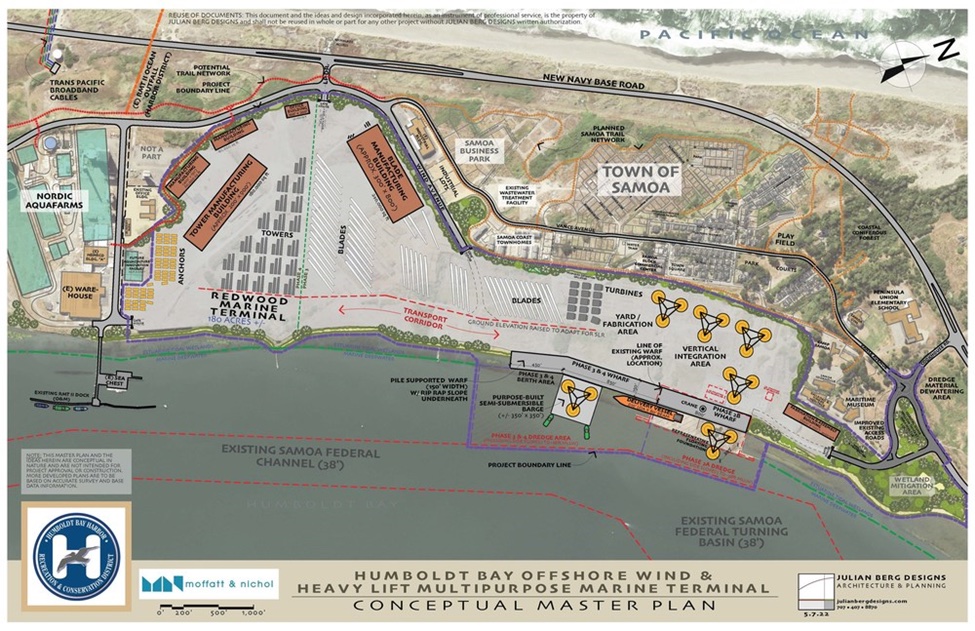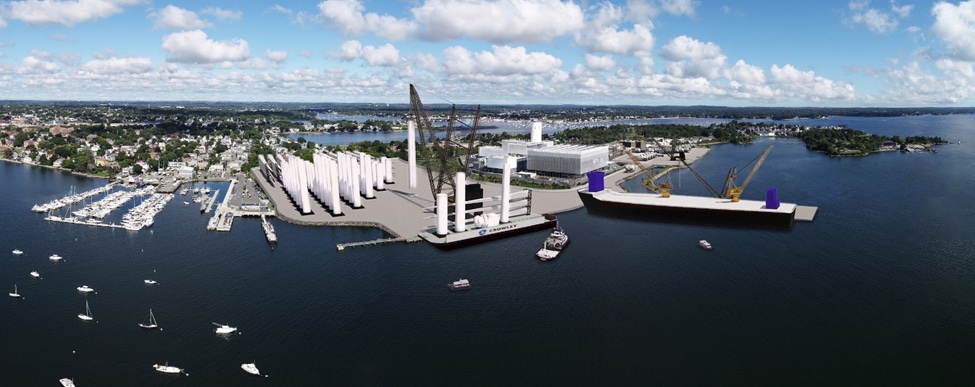On October 27th Crowley Wind Services signed an agreement with the Port of Humboldt Bay to exclusively negotiate to be the developer and operator of a terminal to serve as California's first hub for offshore wind energy installations.
Through Crowley’s Wind Services group, the company will enter into negotiations with the Port to lease and serve as the Port’s developer of the Humboldt Bay Offshore Wind Heavy Lift Marine Terminal.
If an agreement is reached, Crowley will be the exclusive developer/operator of the wind terminal at Humboldt Bay.
In an interview with AJOT, Jeff Andreini, Vice President, Crowley Wind Services explained: “I do not think that many people … realize the momentum that is building for offshore wind that is going to become evident in the second half of this decade. The opportunity in California affords us the ground floor opportunity for us to make a difference not just in California, but also on the U.S. West Coast to structure a supply chain and a workforce.”

Scope of the Wind Farm Project
Andreini said that “figure permitting will be done in April of 2024. Then shovels in the ground thereafter and start up middle of 2026. In 2026, you will be seeing a marshalling area where you will be seeing components. Vessels as well. Anchor handling vessels to tow the turbines out, the floating turbines. You will also be potentially seeing a manufacturing site, but I don’t want to get anybody’s hopes up as of yet. There will be tugs and barges transporting pre-assembled components. In addition, heavy lift ships will be used for the construction of the terminals. There will be heavy lift cranes that will … be doing the actual construction of the turbine. So, the terminal will do the construction of the floaters. The floaters will actually be built in Humboldt Bay and not in a foreign country. There might be materials that might come from Asia, but the pre-construction will potentially (take place) in either San Francisco or Los Angeles and would be shipped to Humboldt Bay where the actual buildout will take place.” Andreini added, “Crowley will be responsible for hiring the stevedores and the crane companies that will do the actual construction of those turbines … These things are gigantic, they dwarf anything from a fixed component standpoint. The (wind turbine) towers are as high as 300 meters (nearly 1,000 feet) … Until the developers are identified in the next two to three weeks, we aren’t going to know which system is going to be used, but (the capacity per wind turbine) might be 15 MWs.”
Employment for the Project
As regards to employment Andreini said, “we’re looking at about 3,200 people. You’re going to need technicians, you’re going to need workers to work on the terminals, mariners working on the vessels themselves, stevedores. We have a relationship with Cal Poly Humboldt to begin that relationship regarding employment and also with Redwood Community College …. There’s going to have to be outreach, we are going to have to find the men and women to work because there’s not enough people available. So how do you reach out to Sacramento and San Francisco to find workers to bring out to Eureka (in Humboldt County, California) to work in the program? You are talking about two different classes of workers, blue caller workers coming from Redwood Community College. Those are the people who will be running through a wielding program or carpentry program or the skills trades that will be needed. The mariners will be coming from California Maritime Academy in Vallejo. And then thirdly, the workers who are strong in the sciences and math and in the STEM (Science, Technology, Engineering and Mathematics) skills will be coming through Cal Poly Humboldt to work in tandem to be successful … We will also be using apprentice programs provided by the California Building Trades to provide qualified workers who have been trained in those apprenticeship programs.”
Drug testing will be a hurdle to potential applicants: “We have not explored the drug testing issue but that may pose a problem in terms of being able to find qualified workers. “
And Andreini said workers will be needed very soon: “We are going to need people on the ground in 2023 to work on planning and permitting issues with the Harbor District … Hiring people ready to work in the construction phase. For that we need to start doing outreach now.”
The plan is to develop interest and skills for the long-term: “You build the workforce by reaching out to the middle schools … so that you can get kids excited about the opportunity that is going to be available to them. That’s going to be the workforce that’s going to be available to you in ten years’ time when California is going to be up and ready at its maximum potential to build and operate floating wind turbines.”
Mass Maritime Collaboration
In 2021, Crowley Maritime Corporation and Massachusetts Maritime Academy (MMA) announced they would be creating “a first-of-its-kind training and workforce development program dedicated specifically to the New England region’s offshore wind energy industry. The partnership, which was announced during the International Offshore Wind Partnering Forum (IPF) conference, will enable the strategic and continued growth of a qualified workforce in the U.S. offshore wind industry, including sea safety and survival instruction. The program will be certified by the Global Wind Organisation (GWO), a non-profit that sets international standards for safety training.”
At that time, Andreini noted: “Crowley and MMA are leaders in the maritime industry, and the joint program will help us build the next generation employees.”
The Salem, Mass Wind Port
In October, Crowley announced that it completed the purchase of 42 acres in Salem, Massachusetts, the latest milestone toward the development of the state’s second major offshore wind port terminal.

The Salem Harbor Wind Terminal is a public-private partnership between Crowley and the City of Salem, with AVANGRID serving as the Port’s anchor tenant through its Commonwealth Wind and Park City Wind projects. The terminal will be a logistics and operations center for turbine pre-assembly, transportation, staging activities and storage of assembly components. Crowley Wind Services, the company’s business unit dedicated to helping develop clean wind energy resources, will operate the terminal.
The terminal site project will result in the redevelopment of the former Salem Harbor Station, a decommissioned coal-fired energy plant creating more than 800 jobs … in the support of the construction and staging of wind projects and daily operations.
The Commonwealth Wind project represents the largest offshore wind project in New England and will create 11,000 full time equivalent jobs over the project’s lifetime while generating enough energy to power 750,000 homes annually, the Crowley announcement said.
Construction of the wind terminal is expected to start in summer 2023, with the terminal complete in 2025.
We Cannot Wait
In conclusion, Andreini said: “We cannot wait. I have been working on this for over a year and a half to get to this point. And this requires us developing relationships with Cal Poly, Cal Maritime, and Redwood Community College. And we already have a relationship with Cal Maritime because we hire some of their graduates as mariners on our vessels.

